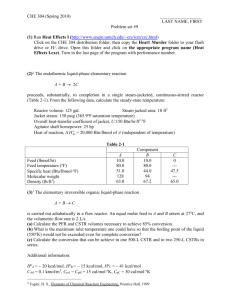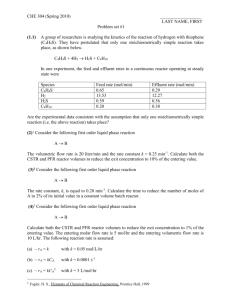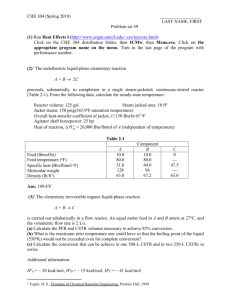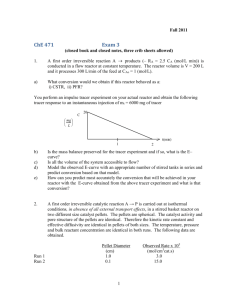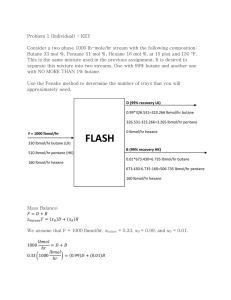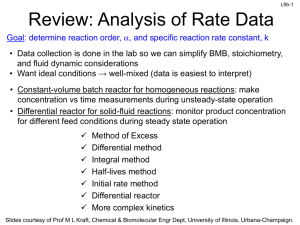Chemical Kinetics Problem Set
advertisement
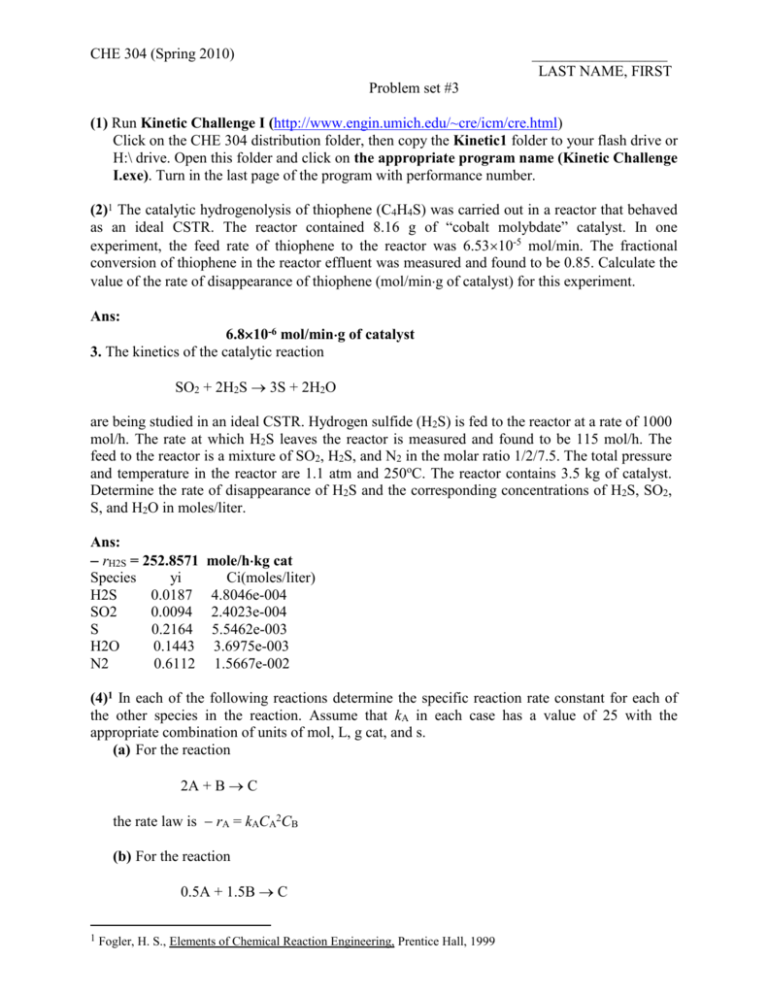
CHE 304 (Spring 2010) __________________ LAST NAME, FIRST Problem set #3 (1) Run Kinetic Challenge I (http://www.engin.umich.edu/~cre/icm/cre.html) Click on the CHE 304 distribution folder, then copy the Kinetic1 folder to your flash drive or H:\ drive. Open this folder and click on the appropriate program name (Kinetic Challenge I.exe). Turn in the last page of the program with performance number. (2)1 The catalytic hydrogenolysis of thiophene (C4H4S) was carried out in a reactor that behaved as an ideal CSTR. The reactor contained 8.16 g of “cobalt molybdate” catalyst. In one experiment, the feed rate of thiophene to the reactor was 6.5310-5 mol/min. The fractional conversion of thiophene in the reactor effluent was measured and found to be 0.85. Calculate the value of the rate of disappearance of thiophene (mol/ming of catalyst) for this experiment. Ans: 6.810-6 mol/ming of catalyst 3. The kinetics of the catalytic reaction SO2 + 2H2S 3S + 2H2O are being studied in an ideal CSTR. Hydrogen sulfide (H2S) is fed to the reactor at a rate of 1000 mol/h. The rate at which H2S leaves the reactor is measured and found to be 115 mol/h. The feed to the reactor is a mixture of SO2, H2S, and N2 in the molar ratio 1/2/7.5. The total pressure and temperature in the reactor are 1.1 atm and 250oC. The reactor contains 3.5 kg of catalyst. Determine the rate of disappearance of H2S and the corresponding concentrations of H2S, SO2, S, and H2O in moles/liter. Ans: rH2S = 252.8571 Species yi H2S 0.0187 SO2 0.0094 S 0.2164 H2O 0.1443 N2 0.6112 mole/hkg cat Ci(moles/liter) 4.8046e-004 2.4023e-004 5.5462e-003 3.6975e-003 1.5667e-002 (4)1 In each of the following reactions determine the specific reaction rate constant for each of the other species in the reaction. Assume that kA in each case has a value of 25 with the appropriate combination of units of mol, L, g cat, and s. (a) For the reaction 2A + B C the rate law is rA = kACA2CB (b) For the reaction 0.5A + 1.5B C 1 Fogler, H. S., Elements of Chemical Reaction Engineering, Prentice Hall, 1999 the rate law is rA = kACACB (c) For the solid catalyzed reaction 4A + 5B 4C + 6D the rate law is r'A = kACA2CB (d) In the homogeneous gas-phase reaction CH4 + 1.5O2 HCOOH + H2O What is the relationship between rCH4 and rO2? Ans: a) kB = 12.5 L2/mol2s, kC = 12.5 L2/mol2s b) kB = 75 L/mols, kC = 50 L/mols c) kB = 31.25 L2/mol2s, kC = 25 L2/mol2s, kD = 37.5 L2/mol2s d) rCH4 = 2 rO2 3 (5)1 Set up a stoichiometric table for each of the following reactions and express the concentration of each species in the reaction as a function of conversion. (a) The liquid-phase reaction CH2OCH2 + H2O OHCH2CH2OH The initial concentrations of ethylene oxide and water are 1 lbmol/ft3 and 3.47 lbmol/ft3, respectively. (b) The isothermal, isobaric gas-phase pyrolysis C2H6 C2H4 + H2 Pure ethane enters the flow reactor at 6 atm and 1100oK. How would your equation for the concentration change if the reaction were to be carried out in a constant-volume batch reactor? (c) The isothermal, isobaric, catalytic gas-phase oxidation C2H4 + 0.5O2 CH2OCH2 The feed enters a PBR at 6 atm and 260oC and is a stoichiometric mixture of oxygen and ethylene. Ans: a) CA = (1 X) lbmol/ft3, CB = (3.47 X) lbmol/ft3, CC = X lbmol/ft3 b) CA = CA0(1 X) , CB = CC = CA0X, CA0 = 0.067 mol/L c) CA = CA0 1 X 1 X X , CB = 0.5CA0 , CC = CA0 , CA0 = 0.092 mol/L 1 X /3 1 X /3 1 X /3 (6) An average person breathes 12 times per minute, inhaling and exhaling 0.5 liters of air per breath. a) Determine the mass in kg of air passing through this person per day. Use air at 25oC, 1 atm, and molecular weight of 29. b) If the air contains 21 mol % oxygen and the exhaled air contains 16 mol % oxygen, estimate the moles of oxygen absorbed by this person per day. c) If all of the absorbed oxygen is used to convert glucose (C6H12O6) into CO2 and H2O. Determine the amount of energy in Kcal used by an average person per day if one mole of glucose reacted will release 2870 kJ. Note: 1 cal = 4.18 J and 1 diet calorie is actually 1 Kcal. Ans: a) mair = 8640 273 29 = 10.2 kg/day 22.4 298 1000 This is the mass of air inhaled for a person at rest. Therefore a person will inhale more than 10 kg of air/day doing regular activities. b) Moles of oxygen absorbed per day = c) Energy used: (10.2)(1000)(0.05) = 17.59 moles (29) (17.59)(2870) = 2012 Kcal (6)(4.18) (7) In ethanol production by fermentation of corn, hydrolyzed ground corn in a water suspension containing 50% corn by weight is mixed with sufficient enzyme to produce ethanol by the approximate reaction2 C6H12O6 2C2H5OH + 2CO2 When the solution reaches 12% ethanol, the yeast dies and the reaction stops. (a) How many bushels of corn are required to produce 500 tons of pure ethanol per day? Assume 1 bushel of corn weighs 56 lb. (b) The process requires 72 hours to go to completion. What size batch-reactor tank or tanks are required for this process? Ans: a) 8.19104 bushels corn/day b) 1.25107 L 2 Schmidt, L.D., The Engineering of Chemical Reactions, Oxford, 2004, pg. 81 (8)3 Calculate the partial pressure of monatomic hydrogen gas at 2000oK and 1 atm pressure. For ½H2(g) H(g) o o H 298 = 217,990 J and S 298 = 49.35 J/K Assume that the heat capacity of H(g) = 1.5R. The heat capacity of H2 can be assumed to be 31 J/(moloK). Ans: PH = 5.2210-4 atm 3 Kyle, B.G., Chemical and Process Thermodynamics, Prentice Hall, 1999


